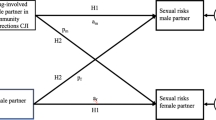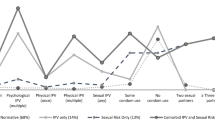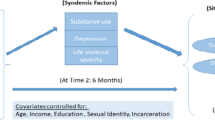Abstract
This study, based on data from a random sample of 322 men on methadone, examines whether traditional male gender role beliefs, male substance use, and couple drug-involvement lead to male psychological dominance, which in turn leads to perpetration of intimate partner violence (IPV) and sexual HIV risk behavior. Structural equation modelingindicated that male psychological dominance is directly associated with perpetrating both physical IPV and sexual HIV risk; however, physical IPV did not lead to sexual HIV risk as predicted originally. Stronger endorsement of traditional male gender role beliefs was associated with male psychological dominance. Couple drug-involvement was also directly associated with male psychological dominance as well as sexual HIV risk. Male substance use led to couple drug-involvement, but not to physical or sexual HIV risk as hypothesized. Study findings highlight the significance of couple drug-involvement and male psychological dominance as pathways leading to physical IPV and sexual HIV risk behavior. Implications for HIV prevention efforts targeting drug-involved men and their sexual partners are discussed.
Similar content being viewed by others
References
Abbot, J., Johnson, R., Koziol-McLain, J., and Lowenstein, S. (1995). Domestic violence against women: Incidence and prevalence in emergency department populations. Journal of the American Medical Association, 273, 1763–1767.
Amaro, H. (1995). Love, sex and power: Considering women’s realities in HIV prevention. American Psychologist, 50, 437–447.
Bastard, B., Cardia-Voneche, L., Peto, D., and Van Campenhoudt, L. (1997). Relationships between sexual partners and ways of adapting to the risk of AIDS: Landmarks for a relationship-oriented conceptual framework. In L. Van Campenhoudt, M. Cohen, G. Guizzardi, and D. Hausser (Eds.), Sexual interactions and HIV risk (pp. 44–58). London: Taylor and Francis.
Becker, M. H. (1974). The Health Belief Model and personal health behavior. Health Education Monograph, 2, 324–473.
Bentler, P. M. (1990). Comparative fit indexes in structural models. Psychological Bulletin, 107, 238–246.
Bentler, P. M. (1995). EQS structural equations program manual (seventh printing, May 1995 ed.). Encino, CA: Multivariate Software, Inc.
Berenson, A. B., Stiglich, N. J., Wilkinson, G. S., and Anderson, G. D. (1991). Drug abuse and other risk factors for physical abuse in pregnancy among white non-Hispanic, Black, and Hispanic women. American Journal of Obstetrics and Gynecology, 164, 1491–1499.
Booth, R. E., Koester, S. K., and Pinto, F. (1995). Gender differences in sex-risk behaviors, economic livelihood and self-concept among drug injectors and crack smokers. American Journal of Addictions, 4, 313–322.
Bruhin, E. (2003). Power, communication and condom use: Patterns of HIV-relevant sexual risk management in heterosexual relationships. AIDS Care, 15, 389–401.
Byrne, B. M. (1994). Structural equation modeling with EQS and EQS/Windows: Basic concepts, applications, and programming. Thousand Oaks, CA: Sage.
Cabral, R. J., Pulley, L., Artz, L. M., Brill, I., and Macaluso, M. (1998). Women at risk of HIV/STD: The importance of male partners as barriers to condom use. AIDS and Behavior, 2, 75–85.
Catania, J. A., Kegeles, S. M., and Coates, T. J. (1990). Towards an understanding of risk behavior: An AIDS Risk Reduction Model (ARRM). Health Education Quarterly, 17, 53–72.
Chiasson, M. A., Stoneburner, R. L., Lifson, A. R., Hildebrandt, D. S., Ewing, W. E., Schultz, S., and Jaffe, H. W. (1990). Risk factors for human immunodeficiency virus type 1 (HIV-1) infection in patients at a sexually transmitted disease clinic in New York City. American Journal of Epidemiology, 131, 208–220.
Coker, A. L., Davis, K. E., Arias, I., Desai, S., and Sanderson, M. (2002). Physical and mental health effects of intimate partner violence for men and women. American Journal of Preventive Medicine, 23, 260–268.
Cunningham, R. M., Stiffman, A. R., Dore, P., and Earls, F. (1994). The association of physical and sexual abuse with HIV risk behaviors in adolescence and young adulthood: Implications for public health. Child Abuse and Neglect, 18, 233–245.
Edlin, B. R., Irwin, K. L., Faruque, S., McCoy, C., Word, C., Serrano, Y., Inciardi, J., Bowser, B., Schilling, R. F., and Holmberg, S. (1994). Intersecting epidemics: Crack cocaine use and HIV infection in inner-city young adults. New England Journal of Medicine, 21, 1422–1427.
Edlin, B. R., Irwin, K. L., Ludwig, D. D., McCoy, H. V., Serrano, Y., Word, C., Bowser, B. P., Faruque, S., McCoy, C. B., and Schilling, R. F. (1992). High-risk sex behavior among young street-recruited crack cocaine smokers in three American cities: An interim report. Journal of Psychoactive Drugs, 24, 363–371.
El-Bassel, N., Fontdevila, J., Gilbert, L., Voisin, D., Richman, B., and Pitchell, P. (2001). HIV risks of men in methadone maintenance treatment programs who abuse their intimate partners: A forgotten issue. Journal of Substance Abuse, 13, 1–15.
El-Bassel, N., Gilbert, L., Rajah, V., Foleno, A., and Frye, V. (2000). Fear and violence: Raising the HIV stakes. AIDS Education and Prevention, 12, 154–170.
El-Bassel, N., Schilling, R. F., Irwin, K. L., Faruque, S., Gilbert, L., Von Bargen, J., Serrano, Y., and Edlin, B. (1997). Sex trading and psychological distress among women recruited from the streets of Harlem. American Journal of Public Health, 87, 66–70.
El-Bassel, N., Witte, S. S., Gilbert, L., Wu, E., Chang, M., Hill, J., and Steinglass, P. (2003). The efficacy of a relationship-based HIV/STD prevention program for heterosexual couples. American Journal of Public Health, 93, 963–969.
Follingstad, D., Brennan, A., Hause, E., Polck, D., and Routledge, L. (1991). Factors moderating physical and psychological symptoms of battered women. Journal of Family Violence, 6, 81.
Gielen, A. C., McDonnel, K., Burke, J. G., and O’Campo, P. (2000). Women’s lives after an HIV positive diagnosis: Disclosure and violence. Maternal and Child Health Journal, 4, 111–120.
Gilbert, L., El-Bassel, N., Schilling, R., Wada, T., and Bennet, B. (2000). Partner violence and sexual HIV risk behaviors among women in methadone treatment. AIDS and Behavior, 4, 261–269.
Gillmore, M. R., Archibald, M. E., Morrison, D. M., Wilsdon, A., Wells, E., Hoppe, M. J., Nahom, D., and Murowchick, E. (2002). Teen sexual behavior: Applicability of the theory of reasoned action. Journal of Marriage and Family, 64, 885–897.
Harlow, L., Quina, K., Morokoff, P., Rose, J., and Grimley, D. (1993). HIV risk in women: A multifaceted model. Journal of Applied Biobehavioral Research, 1, 3–38.
Harvey, M. S., Bird, S. T., Galavoti, C., Duncan, E. A. W., and Greenberg, D. (2002). Relationship power, sexual decision making and condom use among women at risk for HIV/STDs. Women and Health, 36, 69–83.
Herbert, T. B., Silver, R. C., and Ellard, J. H. (1991). Coping with an abusive relationship: How and why do women stay? Journal of Marriage and the Family, 53, 311–325.
Hotaling, G. T., and Sugarman, D. B. (1986). An analysis of risk markers in husband to wife violence: The current state of knowledge. Violence and Victims, 1, 101–124.
Hu, L., and Bentler, P. M. (1998). Fit indices in covariance structure modeling: Sensitivity to underparameterized model misspecification. Psychological Methods, 3, 424–453.
Ingham, R., and van Zessen, G. (1997). From individual properties to interactional processes. In L. Van Campenhoudt, M. Cohen, G. Guizzardi, and D. Hausser (Eds.), Sexual interactions and HIV risk (pp. 83–99). London: Taylor and Francis.
Kishton, J. M., and Widaman, K. F. (1994). Unidimensional vs. domain representative parceling of questionnarie items: An empirical example. Educational and Psychological Measurement, 54, 757–765.
Kline, R. (1998). Principles and practice of structural equation modeling. New York: Guilford Press.
Little, T. D., Cunningham, W. A., Shahar, G., and Widaman, K. F. (2002). To parcel or not to parcel: Exploring the question, weighing the merits. Structural Equation Modeling, 9, 151–173.
MacCallum, R. C., Browne, M. W., and Sugawara, H. M. (1996). Power analysis and determination of sample size for covariance structure modeling. Psychological Methods, 1, 130–149.
Maman, S., Campbell, J., Sweat, M., and Gielen, A. (2000). The intersections of HIV and violence: Directions for future research and interventions. Social Science and Medicine, 50, 459–478.
Marin, B. V., Gomez, C. A., Tschann, J. M., and Gregorich, S. E. (1997). Condom use in unmarried Latino men: A test of cultural constructs. Health Psychology, 15, 458–467.
Marsh, H. W., Hau, K. T., Balla, J. R., and Grayson, D. (1998). Is more ever too much? The number of indicators per factor in confirmatory factor analysis. Multivariate Behavioral Research, 33, 181–220.
Metzger, D. S., Navaline, H., and Woody, G. E. (2000). The role of drug abuse treatment in the prevention of HIV infection. In J. L. Peterson and R. J. DiClemente (Eds.), Handbook of HIV prevention (pp. 145–157). New York: Plenum.
Miller, J. (1995). Gender and power on the streets. Journal of Contemporary Ethnography, 23, 427–452.
Muthen, L., and Muthen, B. (2000). Mplus: The comprehensive modeling program for applied researchers. User’s guide version 2.0. Los Angeles, CA: Muthen and Muthen.
North, R. L., and Rothenberg, K. H. (1993). Partner notification and the threat of domestic violence against women with HIV infection. New England Journal of Medicine, 329, 1194–1196.
O’Leary, A., and Wingood, G. M. (2000). Interventions for sexually active heterosexual women. In J. L. Peterson and R. J. DiClemente (Eds.), Handbook of HIV prevention (pp. 179–197). New York: Plenum.
Pleck, J., Sonenstein, F. L., and Ku, L. C. (1993). Masculinity ideology: Its impact on adolescent males heterosexual relationships. Journal of Social Issues, 49, 11–29.
Pleck, J., Sonenstein, F. L., and Ku, L. C. (1994). Attitudes toward male roles among adolescent males: A discriminant validity analysis. Sex Roles, 30, 481–501.
Pulerwitz, J., Amaro, H., De Jong, W., and Gortmaker, S. L. (2002). Relationship power, condom use and HIV risk among women in the USA. AIDS Care, 14, 789–800.
Pulerwitz, J., Gortmaker, S. L., and DeJong, W. (2000). Measuring sexual relationship power in HIV/STD research. Sex Roles, 42, 637–660.
Quina, K., Harlow, L., Morokoff, P., and Saxon, S. (1997). Interpersonal power and women’s HIV risk. In N. Goldstein and J. Manlowe (Eds.), The gender politics of HIV/AIDS in women (pp. 188–206). New York: New York University Press.
Rosenbaum, A., and O’Leary, K. D. (1981). Marital violence: Characteristics of abusive couples. Journal of Consulting and Clinical Psychology, 49, 63–71.
Smith, D. E. (1982). Sexological aspects of substance use and abuse. Journal of Psychoactive Drugs, 14, 1–3.
Soler, H., Quadagno, D., Sly, D. F., Riehman, K. S., Eberstein, I. W., and Harrison, D. F. (2000). Relationship dynamics, ethnicity and condom use among low-income women. Family Planning Perspectives, 32, 82–88, 101.
Steiger, J. H., and Lind, J. M. (1980). Statistically based tests for the number of common factors. Paper presented at the annual meeting of the Psychometric Society, Iowa City, IA.
Straus, M. A., Hamby, S. L., Boney-McCoy, S., and Sugarman, D. B. (1996). The Revised Conflict Tactics Scales (CTS2): Development and preliminary psychometric data. Journal of Family Issues, 17, 283–316.
Sugarman, D. B., and Frankel, S. L. (1996). Patriarchal ideology and wife-assault: A meta-analytic review. Journal of Family Violence, 11, 13–39.
Susser, E., Desvarieux, M., and Wittkowski, K. (1998). Reporting sexual risk behavior for HIV: A practical risk index and a method for improving risk indices. American Journal of Public Health, 88, 671–674.
Tolman, R. (1999). The validation of the psychological maltreatment of women inventory. Violence and Victims, 14, 25–37.
Walker, L. (1979). The battered woman. New York: Harper and Row.
Wingood, G. M., and DiClemente, R. J. (1997). The effects of an abusive primary partner on the condom use and sexual negotiation practices of African-American women. American Journal of Public Health, 87, 1016–1018.
Wingood, G. M., and DiClemente, R. J. (1998). Partner influences and gender-related factors associated with noncondom use among young adult African American women. American Journal of Community Psychology, 26, 29–51.
Zierler, S. (1997). Hitting hard: HIV and violence. In N. Goldstein and J. Manlowe (Eds.), The gender politics of HIV/AIDS in women (pp. 207–221). New York: New York University.
Author information
Authors and Affiliations
Corresponding author
Rights and permissions
About this article
Cite this article
El-Bassel, N., Gilbert, L., Golder, S. et al. Deconstructing the Relationship Between Intimate Partner Violence and Sexual HIV Risk Among Drug-Involved Men and Their Female Partners. AIDS Behav 8, 429–439 (2004). https://doi.org/10.1007/s10461-004-7327-0
Issue Date:
DOI: https://doi.org/10.1007/s10461-004-7327-0




